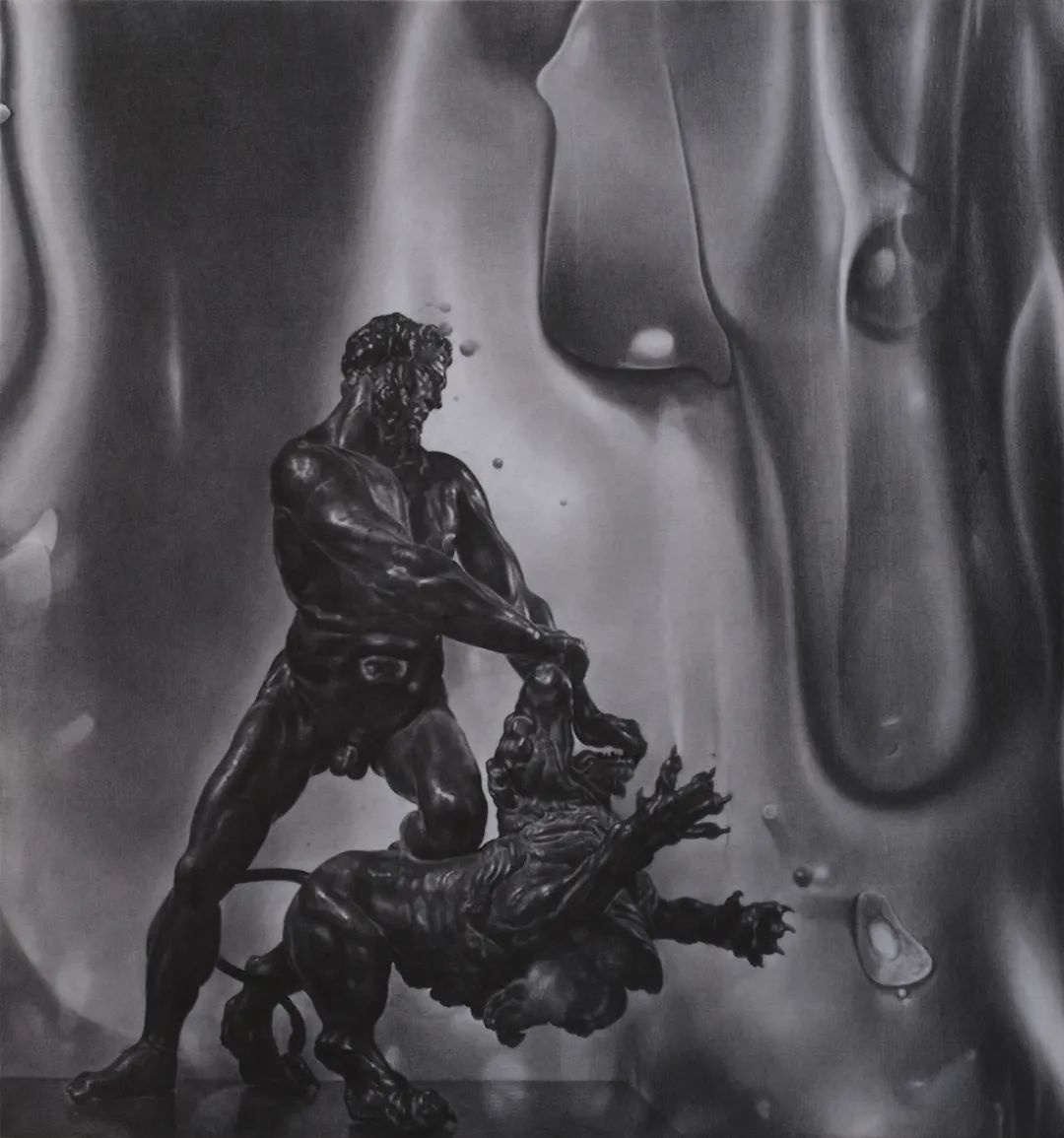
Many viewers are confounded when they step into Zhang Yunyao’s solo exhibition Palace of Extasy at Qiao Space in Shanghai. The bewilderment stems from the visual assault of Greek and Roman images, which has little context in China beyond a few passing references in world history text books. Moving from one enormous panel to another, the term “painting” also proves insufficient in describing the hand-rendered figures that materialize in hyper-realist glory, not as oil on canvas, but rather the unique material of graphite on felt.

Perhaps to ease the conundrum, curator He Jing partitioned the immense warehouse gallery with several walls, prompting the viewer to weave in and out, physically navigating the space as if we ought to observe the paintings like sculptures in-the-round. In the main hall, majority of the felt surfaces embody the likeness of classical marble statues that emerge as if chiseled in stone in pristine form and execution. A striking exception is the large-scale Trace (2016) that positions two overlapping bronze statues. Darkly rendered, it is difficult to confirm whether the two hulking figures personify masters or slaves. The pupils of the subject closer to the foreground seem as if gripped by fear while the eyes of the seated figure in the background are lowered with heaviness. The contradiction in their expressions are made all the more stark by the detailed handling of the bitumen inlay – rare stones that were often inserted as pupils on prominent classical sculptural portraits. The immensely looming forms entice the viewer into the uncharted territory of the exhibition, inviting us into the ambivalent disquietude of history.

Immense and overpowering, the valiant Perseus holding aloft the head of Medusa in Study in Figures (AVIDATIA) (2019) is himself decapitated and fragmented in layers in Zhang’s interpretation of the iconic form. The fierce gesture of Heracles as he grapples a lion with his bare hands in Release (2018) and men abducting a resisting Sabine woman in Study in Figures (2019) signify a declaration of penultimate perfection that are ideal in form and beauty yet remain trapped in haunting paralysis. Despite the dynamic bodily gestures and facial expressions articulated with pronounced naturalism, we nonetheless witness a frozen moment of incapacitating numbness that pays tribute to absolute immobility.

The trope of masculine dominance and sexual assault is reinforced in the adjoining gallery where small-scale graphite paintings are suspended in a dimly lit space. The intimation of sadomasochism that resonate in the outer gallery permeates like a lingering scent that grows in intensity in this much tighter space. The metal poles penetrating from floor to ceiling in the dark cryptic room signal the vibes of a sexualized underground nightclub.

A hauntingly painted torso of an erotic nude Gv (2019) turns his back to the viewer, denying the opportunity to make clandestine eye contact. The perfectly constructed body represented in One Figure (2019) strikes the direct pose of the classical Greek bronze sculpture Riace Warrior (c. 460-450 BCE). His gleaming body lures our gaze, seductively competing for voyeuristic gaze with other images of heads and bodies wrapped tightly and bound in leather. Linking the homosexual societies of classical Greek and Roman epochs with contemporaneous gay culture, the black and white paintings serve as yet another reminder of the cyclical nature of human history.



Throughout human history, structures of power dictate who is able to achieve apotheosis, and it is this notion that Zhang skillfully invites the viewers to consider. Very few, if any, of his depictions can be traced to canonical prototypes since Zhang has bastardized his portrayals of eminent Greek gods, goddesses and Roman emperors through the lens of his own interpretative historical vision. Within the sphere of Zhang’s Palace of Extasy, the cycles of empire building closely intimate the trajectory of lovemaking where foreplay driven by excitement culminates in climactic attainment, which is followed by denouement. The images conjured and sculpted into paintings by Zhang reinforce the historical replay of the rise and fall of ancient empires and dynasties that sought to dominate through structures of hierarchy. Notwithstanding acts of violence evinced through reign of terror or sheer privilege of force, Zhang seems to suggest that even the most Herculean of virile masculine power cannot sustain its erection and will eventually revert to its flaccid position. It’s a piercing insight by a Chinese artist who hearkens from the borders of China’s present empire engaged in a fierce attempt to emerge dominant. The assault of the epic visual narratives of the immortals hearkens as rumination to historical empires that were perceived too great to fail but were ultimately brought to their knees. This is a lesson we have been taught, yet know not how to avert. Because like sex, the pleasures associated with the zeal for hegemony is far too great an aphrodisiac.

Release 释缓, ZHANG Yunyao 张云垚, 2018. Graphite on felt ⽯墨⽑毡, 215 × 200 cm

